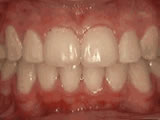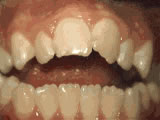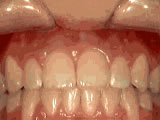Orthodontic Treatments
Common Treatments
Crowding of the teeth


Patient started treatment at age eleven and wore braces for twenty-four months. He loves his new smile.
Openbite: Front teeth don't touch


Patient sucked her thumb as a young child. She started treatment at age thirteen. She had braces and a special appliance — called a crib — to retrain the tongue. Now she can bite the lettuce out of a sandwich.
Deep overbite: Lower front teeth bite into palate


Early intercepting treatment during bone growth is considered the standard today. It is critical to see most patients at 7 years old as proposed by the American Association of Orthodontists for assessment and screening. This adult patient (age twenty-five) required braces and jaw surgery to correct his severe overbite, with treatment taking two years. His problem could have been corrected without surgery if he had been treated before he was a teenager.
Missing lateral incisors


This patient's lateral incisors were congenitally missing. She had braces for twenty months to move the teeth into the correct position, then the missing teeth were replaced with bonded "Maryland" bridges.
Underbite: Lower front teeth in front of upper teeth.


Patient's underbite was causing her jaw joint discomfort and excessive wear patterns on her teeth. After thirty months of treatment starting at age thirty-two, she now finds smiling and chewing much easier.
Overbite: Protruding front teeth


At age ten, patient had a big overbite with the top teeth protruding beyond the bottom. She had two phases of treatment. The first helped her jaws to grow more harmoniously; the second aligned her teeth and bite. At age thirteen, she was proudly displaying her new smile.
Phase I


Non-braces treatment


Sometimes braces are not needed to get noticeable improvements in tooth alignment. This patient was first seen at age seven for crowding of the lower permanent teeth. A procedure was performed to reduce the width of the adjacent baby teeth and the permanent incisors aligned on their own in nine months.
Overbite: Protruding front teeth


At age ten, patient had a big overbite with the top teeth protruding beyond the bottom. She had two phases of treatment. The first helped her jaws to grow more harmoniously; the second aligned her teeth and bite. At age thirteen, she was proudly displaying her new smile.
Common Treatments
What is surgical orthodontics?
Just as orthodontics repositions teeth, surgical orthodontics (also known as orthognathic surgery) corrects jaw irregularities to improve the patient’s ability to chew, speak, and breathe and for improved facial appearances. In other words, surgical orthodontics straightens your jaw. Moving the jaws also moves the teeth, so braces are always performed in conjunction with jaw correction. This helps make sure teeth are in their proper positions after surgery. Dr Pierce has many former adult patients willing to speak with you personally about their successful orthognathic braces-surgery treatment.
Who needs surgical orthodontics?
Your orthodontist will consider surgical orthodontic treatment for non-growing adult patients with improper bites and those with facial aesthetic concerns. Jaw growth is usually completed by age 16 for girls and 18 for boys. All growth must be completed before jaw surgery can be performed. However the pre-surgical tooth movements can begin one to two years prior to these ages.
How does it work?
During your orthodontic treatment, which usually lasts 6–18 months, you wear braces and will visit your orthodontist for scheduled adjustments to your braces. As your teeth move with the braces, your surgeon will monitor where he wants them positioned when the jaws are placed into proper alignment during orthognathic surgery. The teeth will then fit into their proper positions. Surgery is performed in the hospital with an oral surgeon, and can take several hours, depending on the amount and type of surgery needed. Proper alignment, stability and pleasing facial profile can be achieved with the amazing combination of therapies. Harmony and balance in three planes of space can provide patients with that magical change of appearance. Reduction of other facial bones and tissue such as nose, chin, skin and lips can all contribute to that alignment and rubber bands fine tune the bite stability. After surgery, and when complete, retainers are placed as usual. When you have completed surgery, you should be able to return to school or work within two weeks. After the necessary healing time (about 4–8 weeks), your orthodontist "fine-tunes" your bite. In most cases, braces are removed within 6–12 months following surgery. After your braces are removed, you will wear a retainer to maintain your beautiful new smile.
Temporomandibular Disorder (TMJ)
Millions of Americans suffer from chronic facial and neck pain as well as recurrent headaches. In some cases this pain is due to Temporomandibular Disorder, known also as TMJ. Your temporomandibular joints, or jaw joints, connect your lower jawbone to your skull. As you may imagine, these joints get quite a lot of use throughout the day as you speak, chew, swallow, and yawn. Pain in and around these joints can be unpleasant and may even restrict movement.
Symptoms of TMJ include:
• Pain in the jaw area
• Pain, ringing, or stuffiness in the ears
• Frequent headaches or neck aches
• Clicking or popping sound when the jaw moves
• Swelling on the sides of the face
• Muscle spasms in the jaw area
• A change in the alignment of top and bottom teeth
• Locked jaw or limited opening of the mouth
Should you notice any of these symptoms, let us know! We can help advise you as to whether they indicate the presence of TMJ, and what sort of treatment is appropriate for you.
If you don't have any of these symptoms, let's keep it that way! There are some simple things you can do at home or work to prevent TMJ from occurring in your jaw joints:
• Relax your face - remember the rule: "Lips together, teeth apart"
• Avoid grinding your teeth
• Avoid constant gum chewing
• Don't cradle the phone receiver between your head and shoulder - either use a headset or hold the receiver to your ear
• Chew food evenly on both sides of your mouth
• Do not sit with your chin rested on your hand
• Practice good posture - keep your head up, back straight, and shoulders squared